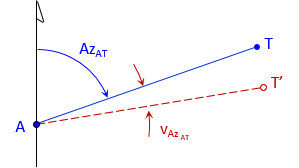Page 3 of 7
3. Azimuth
 |
| Figure F-2 Azimuth Observation |
Equation F-4 is the angle of a line from the meridian in terms of a its coordinates.
 |
Equation F-4 |
|
A: At point |
|
The angle from the meridian can be to the right (+) or to left (-) depending on the coordinate differences signs. This places the angle in one of the four quadrants, Figure F-3.
 |
| Figure F-3 Angle from Meridian |
The value of QAT, added to the angle to obtain the azimuth, depends on the quadrant. Table F-1 shows the sign of α, its quadrant and QAT value.
| Table F-1 Azimuth for a Line ij by Quadrant |
 |
Partial derivatives of Equation F-4 are taken with respect to each coordinate of both points. The partial derivative for NF is:

Remaining partial derivatives are:

Equation F-5 is the azimuth observation equation, evaluated at initial coordinate approximations.
 |
Equation F-5 | |
| Equation F-6 | ||